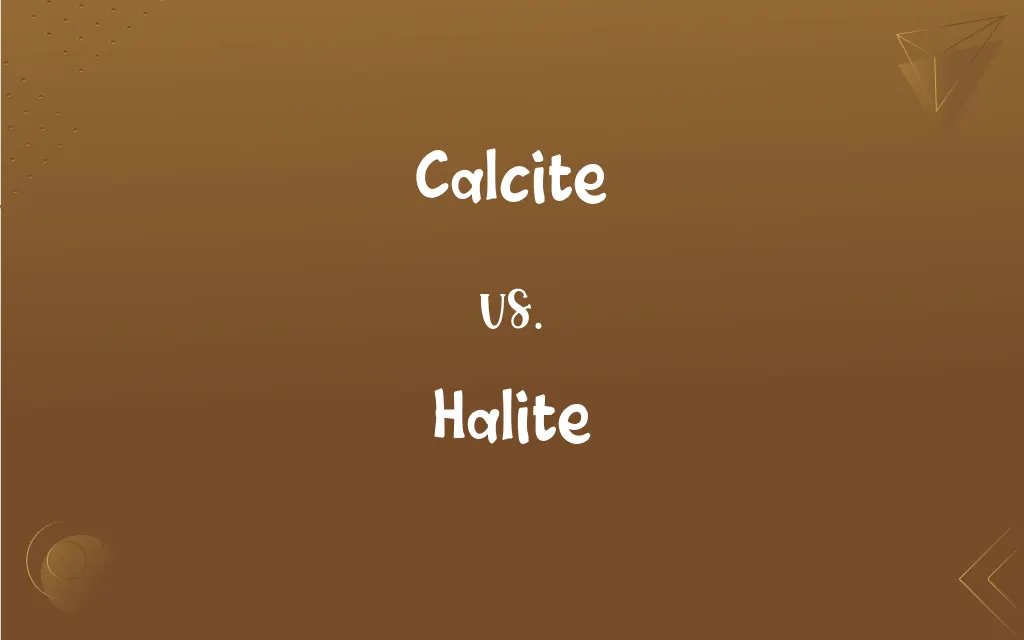Calcite vs. Halite: What's the Difference?
By Janet White || Published on October 8, 2024
Calcite is a carbonate mineral known for its rhombohedral crystal form, while halite is a sodium chloride mineral famous for its cubic crystals.

Key Differences
Calcite, composed primarily of calcium carbonate (CaCO3), is one of the most abundant minerals on Earth's surface, forming a significant part of sedimentary rocks, such as limestone and marble. It is renowned for its wide variety of forms, including its transparent, colorless variety often used in optical instruments. Halite, on the other hand, is the mineral form of sodium chloride (NaCl) and is commonly known as rock salt. It forms through the evaporation of saline waters in arid climates, leading to the creation of salt flats or salt beds.
One of the distinguishing properties of calcite is its birefringence, or double refraction, which causes objects viewed through a clear piece of calcite to appear doubled. This optical property is due to the crystal structure of calcite. Halite, while not exhibiting birefringence, is easily recognizable by its taste, as it tastes distinctly salty. This characteristic makes it easy to identify halite samples.
Calcite reacts vigorously with dilute hydrochloric acid (HCl), producing carbon dioxide bubbles, a reaction that can be used for identification purposes. This reaction is due to the presence of carbonate ions in calcite. Halite does not react with hydrochloric acid but can be dissolved readily in water, reflecting its high solubility and indicating the presence of sodium and chloride ions.
In terms of uses, calcite has a broad range of applications. It is used in the manufacture of cements and mortars, as a flux in the smelting of metallic ores, and in the production of lime for soil conditioning. Its transparent variety is used in optics for the construction of polarizing microscopes and other optical equipment. Halite is primarily used as a source of salt, for human consumption, in food preservation, and as a de-icing agent on roads during winter. It is also utilized in water softening processes.
Both minerals are essential in their own right, with calcite playing a crucial role in the carbon cycle and serving as a major component of limestone, which is used extensively in construction. Halite's role is indispensable in the food industry and in maintaining road safety in icy conditions. Despite their differences, both minerals share the common trait of significantly impacting human life through their various applications.
ADVERTISEMENT
Comparison Chart
Chemical Composition
Calcium Carbonate (CaCO3)
Sodium Chloride (NaCl)
Crystal Form
Rhombohedral
Cubic
Optical Property
Birefringence (Double Refraction)
None
Reaction with HCl
Vigorous effervescence
No reaction
Solubility
Slightly soluble in water
Highly soluble in water
ADVERTISEMENT
Primary Uses
Cement production, soil conditioning, optics
Salt for consumption, de-icing, water softening
Calcite and Halite Definitions
Calcite
A carbonate mineral with the chemical formula CaCO3, known for its varied crystal forms and birefringence.
The clear variety of calcite is used in the lenses of polarizing microscopes to enhance image contrast.
Halite
The mineral form of sodium chloride (NaCl), commonly known as rock salt, characterized by its cubic crystals.
Halite deposits form extensive salt flats, where water has evaporated, leaving behind salt crystals.
Calcite
The optical property of a material to split a beam of light into two rays.
Calcite's birefringence can be demonstrated by placing a crystal over printed text, causing the letters to appear doubled.
Halite
Another term for halite, especially when used in the context of road de-icing or as a seasoning.
Rock salt is spread on highways during winter to melt ice and snow.
Calcite
A crystal shape characteristic of calcite, resembling a distorted cube.
Rhombohedral calcite crystals are often found in sedimentary rock formations.
Halite
The process of removing calcium and magnesium ions from water, often using halite.
Halite is used in water softeners to exchange sodium ions for hard water ions, improving water quality for household use.
Calcite
Transparent calcite used in various optical devices.
Optical calcite is crucial in the construction of certain polarizers for optical equipment.
Halite
The crystal shape typical of halite, defined by three equal axes at right angles.
The cubic crystals of halite can sometimes be seen in the fine structure of table salt.
Calcite
The rapid release of gas bubbles from a liquid, observed when calcite reacts with hydrochloric acid.
Calcite effervescence in contact with dilute HCl is a key test for its identification.
Halite
A method of identifying halite based on its salty taste.
A small lick of a mineral suspected to be halite can confirm its identity due to its unmistakable saltiness.
Calcite
A common crystalline form of natural calcium carbonate, CaCO3, that is the basic constituent of limestone, marble, and chalk. Also called calcspar.
Halite
A colorless or white mineral, NaCl, occurring as cubic crystals and found in dried lakebeds in arid climates, mined or gathered for use as table salt.
Calcite
(mineral) a very widely distributed crystalline form of calcium carbonate, CaCO3, found as limestone, chalk and marble
Halite
Rock salt.
Calcite
Calcium carbonate, or carbonate of lime. It is rhombohedral in its crystallization, and thus distinguished from aragonite. It includes common limestone, chalk, and marble. Called also calc-spar and calcareous spar.
Halite
(mineral) Native salt; sodium chloride NaCl as a mineral; rock salt.
Calcite
A common mineral consisting of crystallized calcium carbonate; a major constituent of limestone
Halite
(chemistry) An oxyanion containing a halogen in the +3 oxidation state.
Halite
Native salt; sodium chloride.
Halite
Naturally occurring crystalline sodium chloride
FAQs
How can I easily distinguish calcite from halite?
Calcite can be distinguished by its reaction with hydrochloric acid (effervescence) and birefringence, while halite is identifiable by its taste and cubic crystals.
How does the solubility of calcite and halite affect their uses?
Calcite's slight solubility is beneficial for soil conditioning by slowly releasing calcium carbonate, whereas halite's high solubility makes it effective for de-icing and food seasoning.
Can calcite and halite be used in jewelry?
Calcite is occasionally used in jewelry, but its softness limits its durability. Halite is rarely used in jewelry due to its solubility in water.
Are calcite and halite found together in nature?
While both minerals can be present in sedimentary environments, they usually form under different conditions; calcite in limestone formations and halite in evaporite deposits.
What role does calcite play in the carbon cycle?
Calcite plays a crucial role in the carbon cycle by storing carbon dioxide in limestone and releasing it during weathering or when limestone is heated in the lime-making process.
How do temperature and pressure affect the formation of calcite and halite?
Calcite forms under a wide range of temperatures and pressures, including at Earth's surface. Halite typically forms at lower pressures and temperatures, primarily through the evaporation of saline waters.
Why is halite used in water softening processes?
Halite is used in water softeners to replace hard water minerals (calcium and magnesium) with sodium, which does not form scale, thereby improving water quality for household and industrial use.
How does the use of halite for road de-icing impact the environment?
The use of halite for de-icing can lead to soil and water pollution due to increased salt levels, affecting vegetation, aquatic life, and water resources, necessitating careful management and alternative de-icing methods.
What advancements have been made in the optical use of calcite?
Advances in precision cutting and polishing of calcite have improved its use in polarizing microscopes and other optical instruments, enhancing its value in scientific and technological applications.
What are the challenges in recycling materials containing calcite and halite?
Recycling materials containing calcite and halite can be challenging due to their solubility and the need to separate them from other materials, but ongoing research aims to improve recycling methods for environmental benefits.
Can the presence of calcite or halite indicate past environmental conditions?
Yes, calcite deposits can indicate past marine environments or hot springs, while halite deposits suggest historic evaporative conditions, such as ancient seas or lakes.
What are the environmental impacts of calcite and halite extraction?
Mining and quarrying for calcite and halite can lead to habitat destruction, water pollution, and increased greenhouse gas emissions. Responsible management and restoration practices are essential to minimize these impacts.
How do cultural perceptions of calcite and halite differ globally?
Cultural perceptions vary, with calcite often valued for its beauty and use in art and architecture, while halite is universally recognized for its essential role in nutrition and food preservation.
Is it safe to consume natural halite directly?
While natural halite is essentially the same as table salt, it may contain impurities; thus, it's safer to consume processed salt intended for dietary use.
Why is birefringence important in optics?
Birefringence is used in optical instruments to manipulate light,enhancing image contrast and enabling the study of materials' optical properties, crucial in scientific research and technology development.
How does the formation environment of calcite and halite impact their mining?
Calcite is mined from limestone or marble quarries, while halite is extracted from underground salt mines or by evaporating saline water from salt pans, reflecting their different formation environments.
Are there health concerns associated with consuming too much halite?
Excessive consumption of halite (salt) can lead to health issues such as hypertension, heart disease, and stroke, highlighting the importance of moderation in dietary salt intake.
Can the presence of calcite in water indicate water quality?
Calcite in water can indicate hard water, which is high in minerals like calcium and magnesium, affecting water taste and potentially leading to scale buildup in pipes and appliances.
Can calcite and halite be synthetically produced?
Both calcite and halite can be synthetically produced for specific industrial applications, offering an alternative to natural extraction that can reduce environmental impacts.
What future research directions exist for calcite and halite?
Future research may explore more sustainable mining techniques, new applications in technology and environmental remediation, and the role of these minerals in addressing climate change impacts.
About Author
Written by
Janet WhiteJanet White has been an esteemed writer and blogger for Difference Wiki. Holding a Master's degree in Science and Medical Journalism from the prestigious Boston University, she has consistently demonstrated her expertise and passion for her field. When she's not immersed in her work, Janet relishes her time exercising, delving into a good book, and cherishing moments with friends and family.






































































